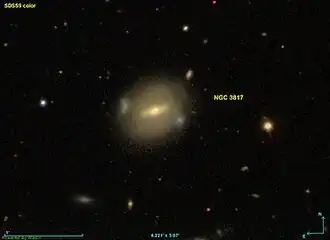NGC 3817
| NGC 3817 | |
|---|---|
 Hubble Space Telescope image of NGC 3817 | |
| Observation data (J2000 epoch) | |
| Constellation | Virgo |
| Right ascension | 11h 41m 52.9487s |
| Declination | +10° 18′ 15.7838″ |
| Redshift | 0.02026 |
| Heliocentric radial velocity | 6210 ± 3 km/s |
| Distance | 91.7 ± 3.1 Mly (28.1 ± 1.0 Mpc) |
| Apparent magnitude (V) | 14.4 |
| Characteristics | |
| Type | SB (R) c |
| Apparent size (V) | 0.677′ × 0.669′ |
| Notable features | LINER-type Active Galaxy Nucleus |
| Other designations | |
| GSC 04937-00483, LEDA 36304, UGCA 243 |SIMBAD=http://simbad.u-strasbg.fr/simbad/sim-id?Ident=NGC3817%7CNASA/IPAC=http://nedwww.ipac.caltech.edu/cgi-bin/nph-objsearch?objname=NGC3817 | |
NGC 3817 is a barred spiral galaxy located approximately 91.7 million light-years away in the constellation Virgo. It was discovered by the German-British astronomer William Herschel on March 15, 1784, using his telescope in Slough, England. Classified as a LINER-type Active Galactic Nucleus (AGN), NGC 3817 exhibits low-ionization nuclear emission lines from its core. With an apparent magnitude of 14.4, the galaxy features a faint ring structure and loosely wound spiral arms.[1]
References
- ^ "NGC 3817 - Lenticular Galaxy in Virgo | TheSkyLive.com". theskylive.com. Retrieved 2024-11-01.